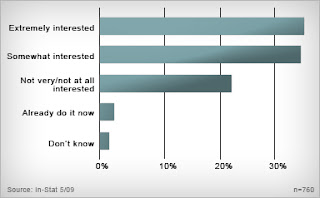
There’s a big difference between the music and the video businesses. Music executives unsuccessfully fought the advent of digital distribution. But media and entertainment industry executives overwhelmingly believe that online distribution of TV shows is an opportunity, not a threat.
Video content creators will embrace online distribution, rather than trying to "kill" or "cripple" it, as music executives did.
Of the 100 executives surveyed recently by Accenture, 70 percent agreed that online distribution of TV shows is more of an opportunity than a threat, given its ability to extend the reach of its programming to a much wider audience at a relatively low cost
compared to traditional broadcasting or physical distribution.
“Technology will continue to alter the distribution landscape, allowing people to access content on their own schedule, wherever they are, in all kinds of ways,” says Leslie Moonves, CBS CEO. “Companies that can combine world-class content with powerful national and local distribution will have the competitive advantage.”
If that is the case, broadband service providers will have some role to play. “We see a big transition moment in the industry,” says Accenture managing consultant consultant Diego Mora Ovideo. “Our telecom clients have many questions about the main battleground.”
“A big question mark is how to change the corporate DNA and business structure to really compete,” he says. In large part, that is because the ecosystem is changing.
“Value is shifting away from simple access,” says Mora Ovideo. And there’s a big shift in Europe that North American carriers will have to confront at some point. “To change their DNA, some are looking at “netco” and “servco” models.
You might call this structural separation or functional separation. Sometimes voluntarily, sometimes involuntarily, telcos are creating distinct organizations to handle retail sales and networks.
“Either there is a formal division into a network business unit and service business units, or sometimes separate organizations are created, without a formal separation of business units, Mora Ovideo says.
“It would be very difficult to think the current business model, skills and mindset will work in the new world,” he adds. Different backgrounds and skills and mindsets are required.
And such reorganizations are being conducted even though the amount of new revenue to be earned from new service offerings is necessarily all that large at the moment. “It isn’t about current volume, but building a position for the future,” he says.
“We must move fast enough o position and have a significant role”, is what service provider execs are saying, he notes. A few leaders like Apple, Nokia, News Corp. and Google are moving very fast, and our clients are moving slower, on purpose, to focus on fixed mobile convergence, substitution and other issues, he says. In the media space, service providers will build partnerships, Mora Ovideo says.
“There’s urgency to act fast,” he says, even though over the next two to three years access will remain the main revenue source.
Some incumbents also are moving to disrupt themselves, accelerating the change, in the voice area. As you would expect, the more aggressive moves often are made by smaller incumbents, who have more to gain from disruptive moves. ‘Absolutely, the weaker incumbents in a market are more likely to launch attacks,” he says.
“In any event, within four or five years, voice will not drive revenue,” he notes.
On the media and content front, 62 percent of executives look to “new platforms” as being the most important key to growth, while 31 percent say “new content” will drive growth, and seven percent say “geographic expansion” is the key growth lever.
Of these new platforms, online and mobile are seen as the key platforms, with a combined 43 percent of execs citing online as most important. Online portals were seen as key by 17 percent of respondents, while 13 percent think social networking sites will be important. About 13 percent think e-commerce sites will be key.
Mobile platforms were seen as key by 17 percent of respondents.
Most think (53 percent) of executives surveyed think “short form content” offers the
largest opportunity for “new content,” with “long form” or “full length” video content (greater than 60 minutes) garnering 11 percent of responses.
Video gaming” was viewed as a key growth area by 13 percent of executives. About 57 percent of respondents think “consumer-based competition” or “user-generated” content is the biggest threat to the media business, while 46 percent also are worried about “piracy or IP theft.”
Still, 68 percent of respondents believe that they will be able to harness user-generated content to create revenue within one to three years.
About 70 percent of respondents also think that social media is a natural evolution of today’s business but will be an evolutionary development. About a quarter of respondents think social media will be “revolutionary” in its impact.
More than 90 percent of the executives said that their companies would become
involved in social media over the next 12 months.








